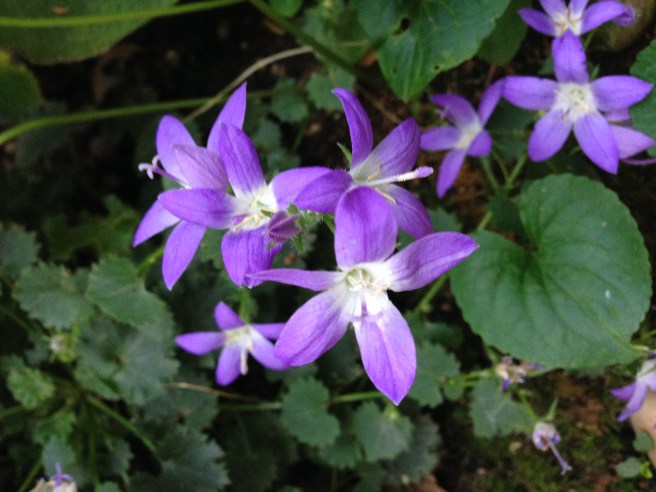Hello, friends! It is heating up fast here and soon instead of dreading the 90s we will be begging for them. The foliage on the several species of Campanula in my garden always looks its best in the spring before it gets too hot but the flowers seem to respond to the warmer days with an explosion of nodding blue bells!
The Campanula, or Bellflower, family is vast and varied with over 300 species including creepers, trailers and taller upright ones like our grandmothers planted and referred to as Cups and Saucers. Most species have bell shaped flowers but many have flowers which start as bells then open into a more star like form. As a family they like rich, well drained soil and full sun only in cooler climates. In my garden they will tolerate morning sun only and probably would be happier (though not bloom as well) with no direct sun at all. While I have had the more upright types in other gardens I have only a few of the lovely creeper/ trailing types now and they are a sight to behold in full bloom. Although literature indicates they are attractive to snails and slugs I have not found that to be true in my beds–perhaps because I have many other lovely delicacies to munch on that they are just full by the time they get to the campanulas.
The upper left photo, taken about a month ago, gives you a chance to see the lovely chartreuse green foliage born by Campanula garganica ‘Dickson’s Gold’. You can see by its neighboring photo that the clump has increased almost enough in size that we have to jump over it rather use the large stepping stones around which it is planted. Although this clumping ground cover lives in my patio shade beds, it does receive a good bit of sun during some parts of the day. Literature suggests that this cultivar, when planted in more shade, will have a more conventional darker green leaf. That would be a crying shame!
The Dalmation Bellflower, Campanula portenschlagiana aka Campanula muralis, is a lovely small scale ground cover which spreads but is not invasive. It is more lavender than blue and has very long trailing stems.
The Serbian Bellflower, Campanula poscharskyana, is a more vigorous ground cover for me. This one is the cultivar ‘Blue Waterfall’. It is exceptionally free flowering and will be covered with blooms for three or more months. A light shearing back of the spent flowers will produce another, though less profuse, full of blooms. ‘Blue Waterfall’ coexists very peacefully with other semi-shade pants and is more reported to be drought tolerant than some campanulas.

‘Blue Gown’, another cultivar of Campanula poscharskyana, has larger flowers with a very distinct large white eye.

This diminutive beauty is a very recent addition to the Secret Garden behind our outdoor pavilion. It is a hybrid of the portenschlagiana and poscharskyana species called ‘Birch Hybrid’. I don’t know who Birch is but I know he is (or was) smart enough to know that both of those “p” botanical names would never fit on a plant tag. The flowers are more prominently bell like than the others I have and the leaves no bigger than the nail on your little thumb. I admit to playing it safe and placing it in full shade, given the lateness of its planting and the rapidly escalating heat. Only time will tell how it fares but this sweet little thing has promise for a lovely small scale ground cover with a cottage feel.
I am always on the look out for campanulas to add to my collection. They are not the flashiest flower in town but are solid performers providing my coveted blue and lavender blooms. I love them for exactly who they are and isn’t that just what we are all looking for in life?
P.S. How many of your eagles eyes noticed in the first two photos the several hostas with actual leaves on them?? I think the snails must be monitoring the garden blogging world and have read my disparaging remarks about their seemingly ravenous attention to every hosta I have ever planted—trying to give me a break this year!







